Introduction to the Peregrine Falcon
Description and Identification
The Peregrine Falcon (Falco peregrinus) belongs to the Order Falconiformes and Family Falconidae (Sibley, 2016). There are twenty-two subspecies worldwide but only three are found in North America (Nature Conservancy Canada, n.d.). Of the three, the first is a resident of British Columbia or Alaska and the second and third are migrants from South or from the high Arctic (Nature Conservancy Canada, n.d.).
In general, both sexes of Peregrine Falcon adults have a dark black head with black sideburns and appear to have a blue-gray plumage with horizontal bars on their breasts (Cornell University: All About Birds, n.d.). They also have a yellow cere and yellow feet (Cornell University: All About Birds, n.d.). The juveniles are a darker brown with a blueish cere and have vertical bars all over their chests (Cornell University: All About Birds, n.d.). There is some variation in darkness of plumage that occurs depending on geographic location in which there is a scale from a darker shade to a lighter shade resulting in the classification of Pacific (darker), Anatun or Tundra (lighter) (Sibley, 2016). Also, an important feature to look for when examining any falcon species is their tomial tooth which is specialized for killing their prey.
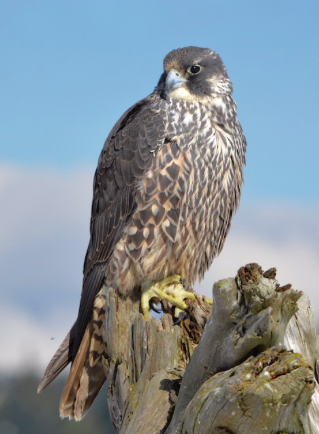
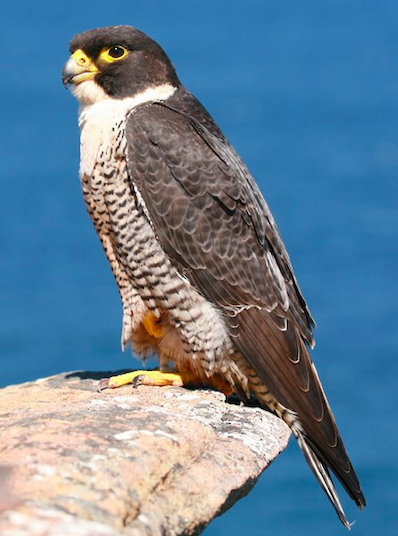
Although Peregrine Falcons are generally the size of a crow, they are considered to be one of the largest falcons but the females are typically larger than the males (Cornell University: All About Birds, n.d.). It is often easy to confuse Peregrines with other species such as Merlins and Gyrfalcons so it is important to examine their wings and tail! Both their tail and wings are long and pointed and they have underwings that are uniformly barred (Cornell University: All About Birds, n.d.).
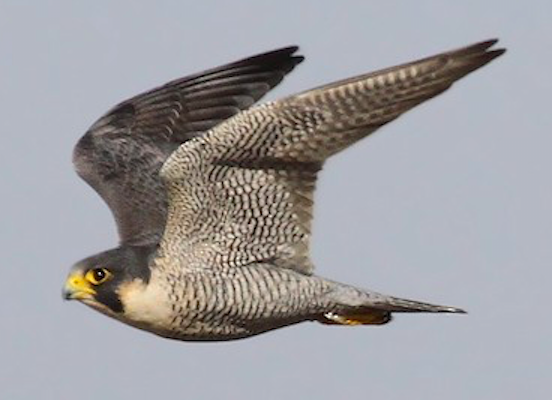
Another identifying feature that the Peregrine Falcon possesses is its unique song and calls. In general, their calls are loud and quite harsh sequences of “kak, kak, kak” (Cornell University: All About Birds, n.d.) as heard in audio 1 & 2. Their call is used to announce fear in some way such as when a predator is near. Predators that could result in both the calls heard in Audio 1 & 2 could include Gyrfalcons, Eagles, Great-Horned Owls or other falcons (Cornell University: All About Birds, n.d.).
Their individualized song is much more common in terms of courtship. In Audio 3, you can hear the beautiful song of a male Peregrine Falcon attracting a nearby female to a new nesting location.
Distribution & Habitat
Peregrine Falcons are definitely not picky in terms of their habitat and nesting locations. They can be found living anywhere from tundras to desert mountains and anywhere in between (Audubon, 2019). They are often on cliffs, in the open country and are also frequently forced to live within cities where they can find perches (Audubon, 2019). When outside cities, they are often spotted along the coast lines where they will frequently adventure far out above the ocean (Audubon, 2019).
As you can probably already assume from the Peregrine Falcon’s very diverse habitats and nesting areas, their distribution on Earth also has great diversity. They can be found on all of the continents except for Antarctica (Nature Conservancy Canada, n.d.).
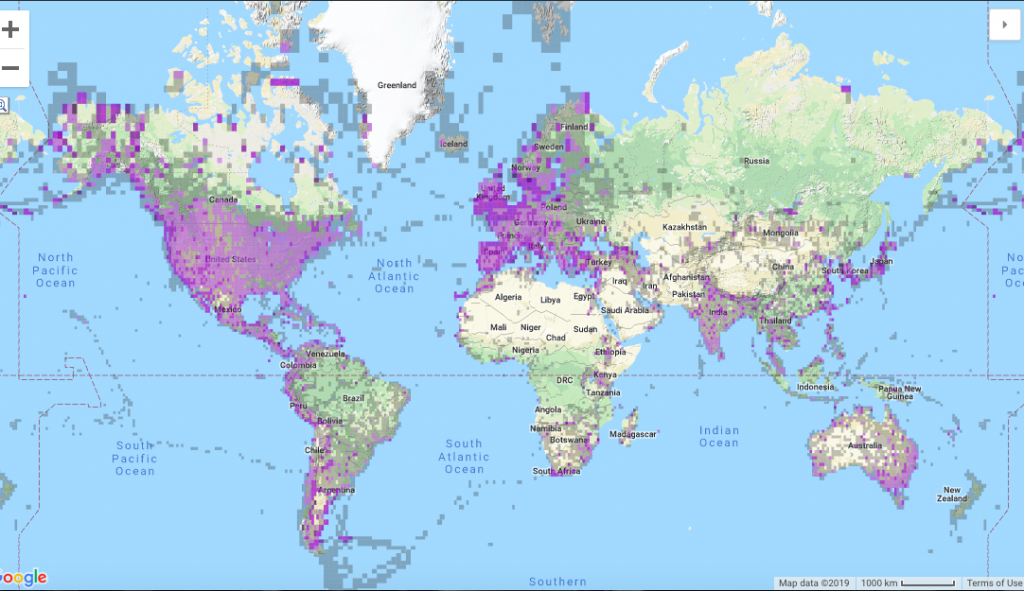
(eBird, 2019)
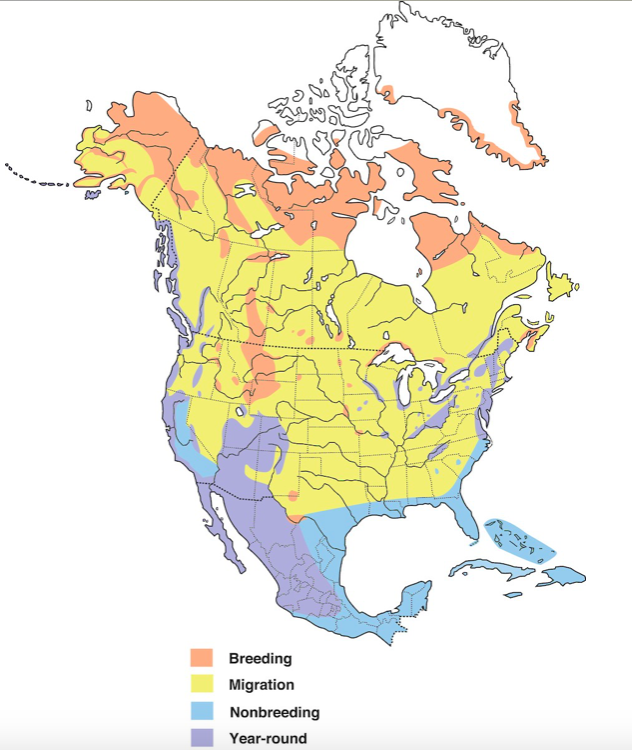
Behaviour
This spectacular bird is often seen soaring high above or perched along edges at nesting sites.
Peregrine Falcons are very successful hunters who feed on a variety of birds and bats. A total of 450 different species of birds has been documented as their prey in North America alone and predicted to be around 2000 species worldwide (Cornell University: All About Birds, n.d.). Prey size is not really an issue as they eat birds as big as a sandhill crane and as small as hummingbirds (Cornell University: All About Birds, n.d.). They have also been known to steal food such as fish and rodents from other raptors (Cornell University: All About Birds, n.d.).
Many methods are used to catch their prey but the most common way involves a stoop from great heights where the Peregrine Falcon drops down upon its prey to either directly grab it or hit it with its feet to stun it (Mills, Hildenbrandt, Taylor, & Hemelrijk, 2018). This often occurs in wide open clearings which allow for enough space to perform their stoop (Mills, Hildenbrandt, Taylor, & Hemelrijk, 2018). Once stunned the prey is picked up by the neck, killing it in the process (Cornell University: All About Birds, n.d.). Other methods include level pursuit, hunting on the ground or picking birds straight out of flocks (Cornell University: All About Birds, n.d.).
Their nesting behaviour involves the males finding a few open perches on the ledges of cliffs or buildings and then the female comes along and takes her pick (Cornell University: All About Birds, n.d.). An interesting fact about their nest building is that they don’t really do it – at least not in the traditional way but instead undergo a “ritualized scraping” (Cornell University: All About Birds, n.d.). This scraping creates a depression at the nest area that has a diameter of 9 inches and a depth of 2 inches (Cornell University: All About Birds, n.d.). These nest sites are used for one brood of anywhere between 2-5 eggs (Cornell University: All About Birds, n.d.).
An interesting connection showing how truly clever these birds are occurs between Peregrine Falcons’ nesting behaviours and their hunting style within New York City at the Empire State Building. DeCandido and Allen (2006) determined in their study that the Peregrine Falcon’s were nesting on skyscrapers and conducting nocturnal hunting of migratory birds. The skyscrapers provided a high enough perch so they could still conduct their stoops while the bright lights of the city often caused disorientation and confusion to their prey resulting in much easier predation (DeCandido & Allen, 2006).
Flight: The World’s Fastest Animal
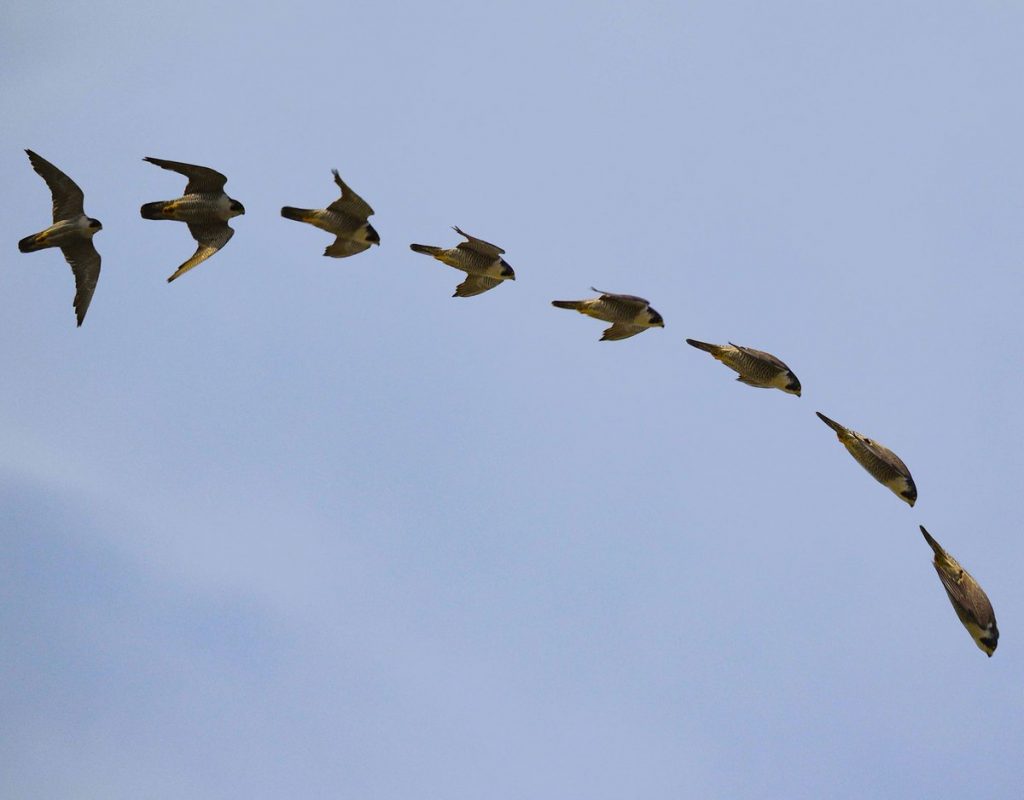
Photo: (Wildlifetog, 2018)
One of the most fascinating abilities of the Peregrine Falcon is their speed during diving flight. They have been labelled as one of the fastest birds in the world due to their ability to reach speeds of 150km/hr during horizontal flight and up to 320km/hr during vertical dives (Ponitz, Schmitz, Fischer, Bleckmann, & Brücker, 2014). To increase flight aerodynamics, birds often undergo morphing wing which is when a bird changes their wing shape (Ponitz, Schmitz, Fischer, Bleckmann, & Brücker, 2014). A Peregrine Falcon’s morphing wing follows the sequence of diamond shaped wings, a tight vertical tuck and a tight wrapped vacuum wrap as their speed increases (Ponitz, Schmitz, Fischer, Bleckmann, & Brücker, 2014). Another important aspect of their flight is that they show great maneuverability at these incredibly fast speeds which is used during their courtship behaviour (Ponitz, Schmitz, Fischer, Bleckmann, & Brücker, 2014).
With such great speeds, the Peregrine Falcon has certain adaptations to protect them during high speeds that have even been examined when trying to solve jet aircraft problems (DeYoung, n.d.). To protect their lungs during flight, they have cone-shaped bones near their nostrils called baffles which deflect shockwaves of air (DeYoung, n.d.). A similar cone approach has been used in aircraft engine openings (DeYoung, n.d.). Another adaptation has to do with their black sideburns which are used to minimize sun glare enhancing their hunting ability (DeYoung, n.d.).
Conservation History and Current Status
Peregrine Falcon’s have made a remarkable comeback over the last few years going from being classified as an endangered species to a species of low concern. They became endangered due to pesticides such as DDT during the 1950’s to 1970’s but due to conservation efforts and the banning of DDT, their breeding population has shown significant increases (Moore et al., 2019). Conservation efforts resulted in the reintroduction in North America’s temperate areas as well as their Arctic nesting populations (Audubon, 2019).
Although the Peregrine Falcon population is considered stable at this time, their climate is considered threatened (Audubon, 2019). The major concerns caused by predicted increased temperatures could cause issues for the Peregrine Falcon populations by causing fires and spring heat waves (Audubon, 2019).
Recent Research on Peregrine Falcon’s
Climate Change = Rainfall and Nestling Mortality
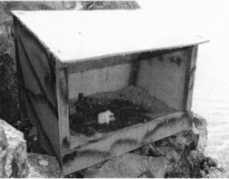
A study published in 2014 was one of the first of its kind to examine the affects that rainfall has on wild birds. The focus was on arctic Peregrine Falcon’s which have recently seen some declines in productivity even though pesticide presence has decreased (Anctil, Franke, & Bêty, 2014). Being in the arctic, these magnificent birds of prey will be expected to experience large impacts from climate change (Anctil, Franke, & Bêty, 2014). The study involved placing nest boxes which would protect some Peregrine’s nests from the rain while comparing to the normal nesting sites (Anctil, Franke, & Bêty, 2014). Results showed that the frequency of heavy rain had a large affect on nestling survival compared to the amount of rain throughout the time the nestlings are cared for (Anctil, Franke, & Bêty, 2014). Since climate change is creating these frequent periods of heavy rain, it is important to understand that the Peregrine Falcon’s populations may be altered — once again causing a change in their conservation status.
Benefits of Sexual Size Dimorphism in Peregrine Falcons
A study was recently conducted that examined the division of labour between the different sexes while hunting prey at incredible speeds (Mills, Taylor, & Hemelrijk, 2019). The sexual dimorphism, meaning different characteristics for each sex other then their reproductive organs, is believed to be due to the idea that the larger females can catch larger prey and males who are smaller can catch the more maneuverable prey (Mills, Taylor, & Hemelrijk, 2019). To determine whether this adaptation is true and not just due to what prey is available at the time, three computer stimulated experiments were conducted.
The first experiment tested Peregrine Falcon’s ability to catch a variety of different prey and the second and third experiments tested the properties of the prey that vary predator success and the properties that allow Peregrine Falcons to have success, respectively (Mills, Taylor, & Hemelrijk, 2019). The stimulations ensured to incorporate high altitude flight, free movement, and random prey movement (Mills, Taylor, & Hemelrijk, 2019).
The experiments determined that both males and females abilities during flight to catch agile prey was very similar (Mills, Taylor, & Hemelrijk, 2019). Females were originally believed to be a lot less agile than males but due to the balance between their low aspect ratio and larger mass and wing area, there was actually only a slight difference (Mills, Taylor, & Hemelrijk, 2019). The differences didn’t seem to be an issue when stooping at high speeds although females were still the only ones capable of catching larger prey (Mills, Taylor, & Hemelrijk, 2019). However, they did determine that since males are much smaller in size, they are more likely to do the hunting for females as they require less energy to do so (Mills, Taylor, & Hemelrijk, 2019). Maybe this energy requirement control is reason for sexual dimorphism? In conclusion, they are still unsure whether the slight differences have anything to do with the adaptation of sexual dimorphism in Peregrine Falcons but it does leave room for future research.
REFERENCES:
Anctil, A., Franke, A., & Bêty, J. (2014). Heavy rainfall increases nestling mortality of an arctic top predator: experimental evidence and long-term trend in peregrine falcons. Oecologia, 174(3), 1033–1043. doi: 10.1007/s00442-013-2800-y
Audubon. (2019). Retrieved October 20, 2019, from https://www.audubon.org/field-guide/bird/peregrine-falcon
Cornell University: All About Birds. (n.d.). Retrieved October 20, 2019, from https://www.allaboutbirds.org/guide/Peregrine_Falcon/id
Decandido, R., & Allen, D. (2006). Nocturnal Hunting By Peregrine Falcons At The Empire State Building, New York City. The Wilson Journal of Ornithology, 118(1), 53–58. doi: 10.1676/1559-4491(2006)118[0053:nhbpfa]2.0.co;2
DeYoung, D. (n.d.). Peregrine Falcon. Retrieved from http://www.discoveryofdesign.com/id116.html.
Mills, R., Hildenbrandt, H., Taylor, G. K., & Hemelrijk, C. K. (2018). Physics-based simulations of aerial attacks by peregrine falcons reveal that stooping at high speed maximizes catch success against agile prey. PLOS Computational Biology, 14(4). doi: 10.1371/journal.pcbi.1006044
Mills, R., Taylor, G. K., & Hemelrijk, C. K. (2019). Sexual size dimorphism, prey morphology and catch success in relation to flight mechanics in the peregrine falcon: a simulation study. Journal of Avian Biology, 50(3), 1–14. doi: 10.1111/jav.01979
Moore, B. A., Murphy, C. J., Marlar, A., Dubielzig, R. R., Teixeira, L. B. C., Ferrier, W. T., & Hollingsworth, S. R. (2019). Presumed Photoreceptor Dysplasias In Peregrine Falcons (Falco Peregrinus) And Peregrine Falcon Hybrids. Journal of Wildlife Diseases, 55(2), 325–334. doi: 10.7589/2018-02-055
Nature Conservancy Canada. (n.d.). Retrieved October 29, 2019, from http://www.natureconservancy.ca/en/what-we-do/resource-centre/featured-species/birds/peregrine-falcon.html.
Ponitz, B., Schmitz, A., Fischer, D., Bleckmann, H., & Brücker, C. (2014). Diving-Flight Aerodynamics of a Peregrine Falcon (Falco peregrinus). PLoS ONE, 9(2). doi: 10.1371/journal.pone.0086506
Sibley, D. A. (2016). Sibley Birds West: The Sibley field guide to birds of Western North America. New York: Alfred A. Knopf.
Hi Danielle,
Great blog! These guys are so cool! I liked your comparison of the adult and juvenile birds – I did not notice before the blueish colour of the cere in juvenile birds. I also liked your warning to be careful and make sure you haven’t stumbled upon a Gyrfalcon!
Also, holy heck (!) Peregrine Falcons can take down a Sandhill Crane?! Now THAT is pretty neat. Those must be some very bold and very hungry birds I would imagine.
I have a question regarding their nesting behaviour and the study on nesting. So you mention that Peregrine Falcons scrape a depression for their nest on cliff edges. This seems to me like a fairly exposed nest, right? However, you also mention that in the study, researchers put out nest boxes for these raptors. Would Peregrines even want to use those nest boxes if their nesting behaviour involves making open nests on ledges?
Thank you for sharing all the neatness of the Peregrine Falcon! Great job!
Samuelle
Hey Sam! Thanks for reading my blog! The hunting abilities of these birds are really cool and I agree that they must be quite hungry to want to take out such a large bird!
About the nest boxes used in the study, it said that they created nest boxes that were built and painted to resemble a natural nesting cliff and they were basically just covered ledges instead of uncovered ones which were the control. The boxes were also filled with the natural sand and substrate that would be found on the cliffs that they would normally nest.
Here’s the link to the study: https://www-jstor-org.ezproxy.viu.ca/stable/24034292?pq-origsite=summon&seq=4#metadata_info_tab_contents
There is a picture of one of the nest boxes in the article on page 1036. (I tried to post the image here but it wouldn’t let me so I’ll add it in my blog shortly).
Hey Danielle,
Really enjoyed reading your blog, thanks for posting!
I was fascinated at the speeds that these guys can achieve during a dive, and it made me wonder if you came across any information on if those high speeds wear down on their feathers faster than slower birds?
Cheers,
Dan
Hi Daniel,
Thank you for your kind comments and for reading my blog.
I wasn’t able to find anything on whether the high speeds result in increased feather damage compared to slower birds, however I did read that the Peregrine Falcon has very slim and stiff feathers instead of loose, limp feathers which result in reduced drag during stoops. With less drag, I would assume there is actually less affects from the wind produced at such high speeds.
Also, I found quite a few articles referring to rehab centres repairing Peregrine Falcon feathers due to their large importance for their high speed stoops and therefore their ability to hunt. With this in mind, I would think that damage is mainly due to accidents instead of wear and tear or rehab centres would probably be full of Peregrines. Just for interest, the conducted repair in the articles was known as Imping. It is basically the transplant of donor feathers from other birds moults or birds that have passed away. Here is a link to the article about imping: https://www.birdrescuecenter.org/rebuilding-a-peregrine-falcon/
Thanks for the question!
Danielle
Hi Danielle,
Peregrine Falcons are super interesting! It would be my favourite bird if Turkey Vultures weren’t also really cool!
I didn’t realize there were so many different subspecies of Peregrine Falcon. You mentioned that subspecies vary in the darkness of their plumage depending on geographic location. Do you know what it is about the differing environments that lead to variation in darkness?
Thanks,
Sarah
Hi Sarah,
Thanks so much for reading my blog!
I found an article on the Cornell Lab of Ornithology that discussed these variations. The variations follow a rule known as Gloger’s Rule where the darker plumage shades are found in areas of higher relative humidity. The Tundra subspecies are found in cold, dry climates and are a much lighter shade and the Pacific subspecies are found in humid climates and are much darker. There is also a third subspecies, known as Anatun that is in-between the other two with plumage containing bits of browns and reds and is found in hot, dry climates. However, this subspecies is either a year round resident or short-distance migrants but little is actually known about their migration patterns.
Here is a link to the article: https://birdsna.org/Species-Account/bna/species/perfal/systematics
Thanks again for reading my blog, and for the great question!
Danielle
Hi Danielle, loved the read! After seeing sandhill cranes at reifel over the weekend, its pretty crazy peregrines can eat those massive guys! Also, I found it interesting that peregrines are benefiting from skyscrapers; did you find any information on if peregrines are becoming more successful in urban environments due to this ?
Hey,
Thanks for reading my blog! I completely agree, these guys’ hunting ability is incredible!
I didn’t find anything more about their ability to thrive in urban environments, however these environments don’t seem to be holding Peregrine Falcons back in any way! They are often found nesting within the city very comfortably and the many buildings supply them with high enough perches to continue their successful hunting methods. Then, the skyscraper article had a focus on how they were more successful than the other birds because they didn’t seem to become disoriented or confused by the urban lights which is a great example of how they have become successful in urban environments.
Thanks again for reading and for the question!
Danielle
Hi Danielle.
I really enjoyed your blog! The facts about the morphing wings in dive and the picture you found for the transformation are so cool! They definitely make me want to find one during my birdwatching. Also the research about the sexual dimorphism is very interesting to learn because I did not know their sexes differ in sizes and furthermore, their ability to pursuit is not yet significantly different.
I’m curious if there is any other bird that competes with the Peregrine Falcon in their habitat or if there is any potential predator to this fast flying bird in nature.
Hideki
Hi Hideki,
Thanks so much for reading my blog! The Peregrine Falcon dive is so cool!
As for your question, the Peregrine Falcon is near the top of the food chain but it does have some predators in nature. These include other larger birds such as Gyrfalcons, Eagles, Great-Horned Owls and other Peregrine Falcons. Also, their nests can be in danger from mammals such as bears, wolves, foxes, wolverines and cats.
I also found some interesting information about different species driving off Peregrine Falcons during times of serious conservation efforts and reintroduction of the species. For example, Great Horned Owls would prevent the Peregrines from forming any sort of establishment in the area and Eagle Owls resulted in decreased Peregrine nests in areas where cliffs were not frequent in France. Also, the Common Raven has been known to disturb Peregrine breeding.
Thanks for your question!
Danielle
Hi Danielle!
Wonderful blog! Peregrine Falcons are super cool. Watching them fly is a marvel of nature and quite a feat!
You mentioned research being done on nesting cavities and decreased nestling survival due to increased rainfall. I was wondering what the hypotheses were on this? Are they not surviving because higher rainfall levels destroy the nest?
Thanks,
Melissa
Hi Melissa,
Thanks for reading my blog!
To answer your question, in the study, they basically started by discussing how rainfall has been previously directly related to the breeding success of many bird species. Then they decided that since the Arctic will likely undergo extreme effects due to climate change, it would be interesting to determine the direct effect of rain (and therefore climate change) on nestling survival for a top arctic predator such as the Peregrine Falcon. They used two groups in the experiment which were covered nests and uncovered nests and their hypothesis was that, “nestlings that received improved shelter from the rain would experience higher survival rates than those that remained unprotected”. In conclusion, their observational experiment showed that the protected nests had greater nestling survival than the uncovered nests who were experiencing the heavy rain. Therefore, yes, the greater periods of heavy rainfall were seen to show higher nestling mortality in Peregrine Falcons. It stated that the deaths due to rainfall were due to nest destruction and situations where nestlings were knocked out of nests due to poor visibility and conditions.
Thanks for the great question! I hope my answer clears it up!
Danielle